NVIDIA's GeForce GT 430: The Next HTPC King?
by Ryan Smith & Ganesh T S on October 11, 2010 9:00 AM ESTPower, Temperature, & Noise
We only have 1 GT 430 card on hand, so unlike past articles we cannot compile any data on the load voltages of this line of cards. Our lone Asus card has a load voltage of 1.08v, and an idle voltage of 0.88v. Idle clocks are 50.6MHz for the core, and 270MHz effective for the memory.
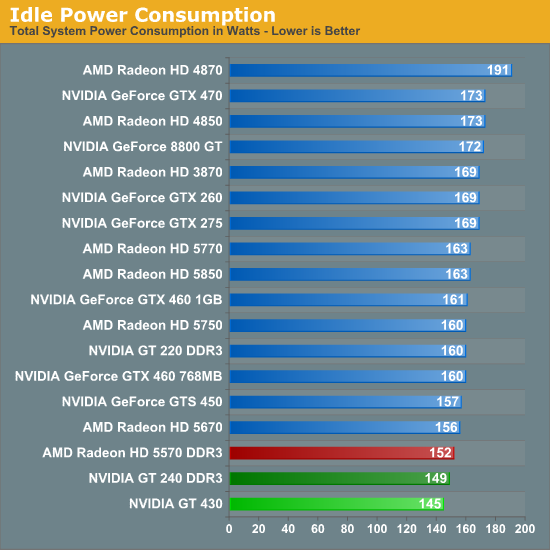
While GT 430 may not be competitive on a performance-per-dollar basis, it’s hard to argue with these power results. Even at these low wattages where our 1200W power supply isn’t very efficient, the GT 430 still delivers an idle power consumption level 7W under the Radeon 5570, and an even larger 11W advantage over the otherwise performance-superior Radeon 5670. We can’t measure the card’s actual power consumption and NVIDIA does not provide a reference level, but the GT 430 can’t be drawing more than a couple of watts here.
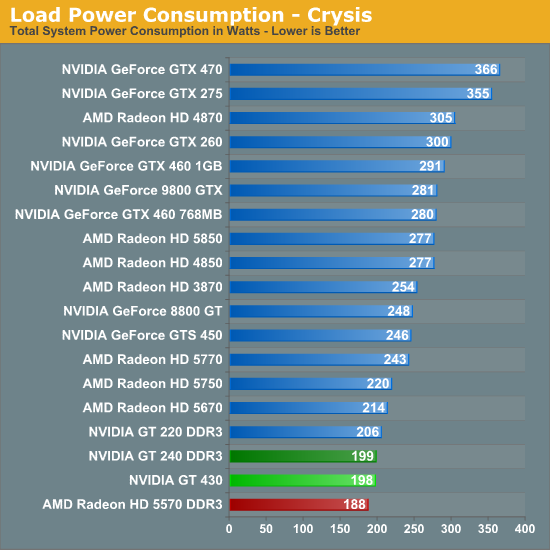
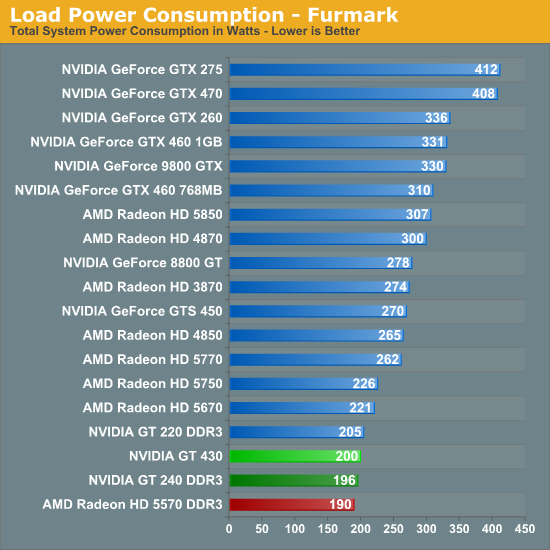
Under load things are less rosy for the GT 430. Under Crysis it ends up drawing 10W over the 5570, which serves as yet another testament to the amazing level of performance-per-watt that AMD has been able to attain; remember that the 5570 had better performance at the same time. Under Furmark the situation is just as bad, but at this point we’re looking at a more pathological case. Overall 10W isn’t going to break the bank in an HTPC (especially since these cards would rarely get up to full clocks in the first place) but it’s something to consider if every watt is going to count.
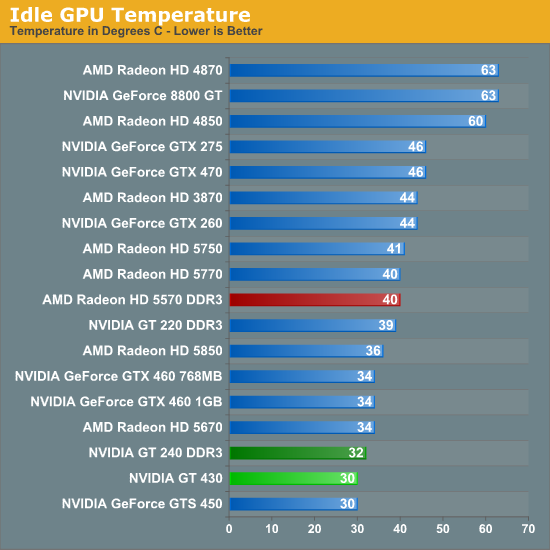
When it comes to idle temperatures, the GT 430 is second to none. With the card only consuming a couple of watts at idle in the first place, its idle temperatures are barely above room temperature (and even closer to ambient case temperatures). It’s tied with the GTS 450, which impressed us last month with its highly capable cooler. Meanwhile our 5570, which is a low-profile card just like the GT 430, ends up being a good 10C higher. AMD’s higher idle power consumption directly translates to a higher idle temperature.
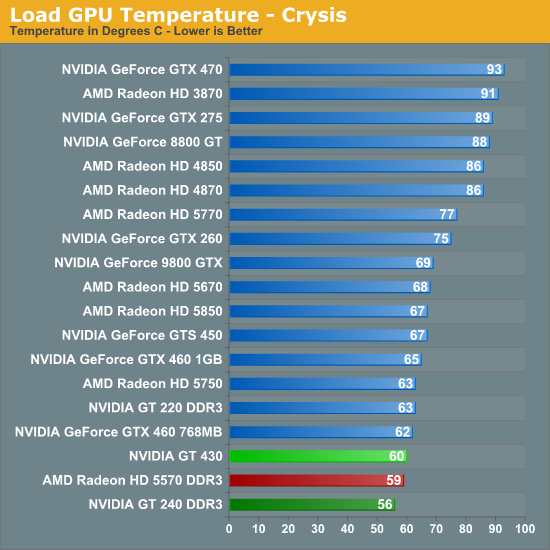
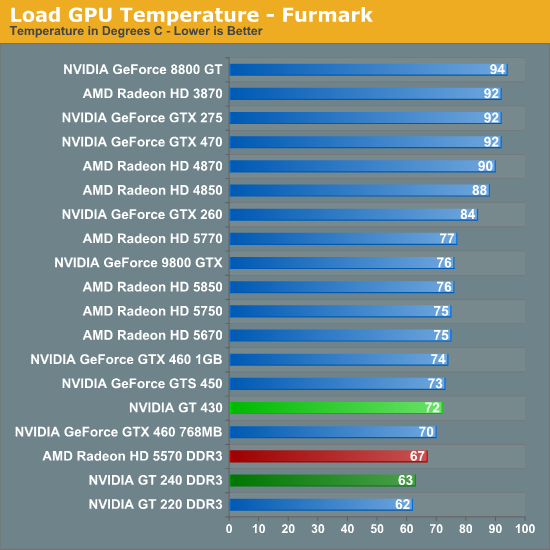
Looking at load temperatures, these results aren’t all that surprising given the cooler in use. The Asus cooler is practically a passive cooler, as the small fan is not capable of moving much air (though it is unusual to not see Asus aggressive on cooling). As a result it manages to reach higher temperatures, but we’re still only talking about 60C under Crysis and 72C under Furmark. This is worse than the 5570 and its larger fan by a bit, but not significantly so.
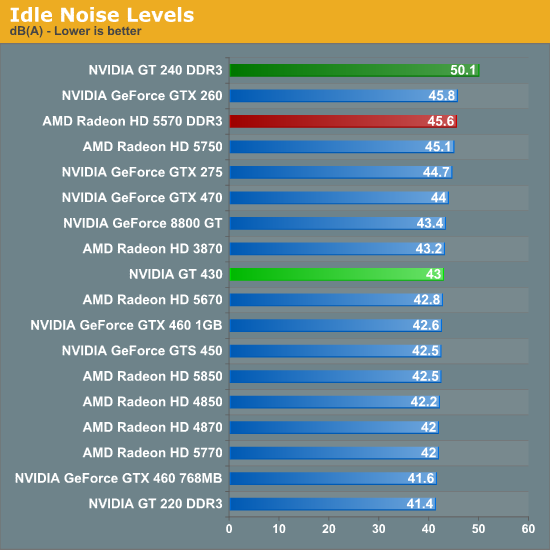
At idle the GT 430 is consistent with our other cards. With the exception of a couple ridiculous cards like our GT 240 and in this case the 5570, everything is at roughly 42-44dB(A). The 5570 is more fan than heatsink, which is likely why it has such a poor showing here compared to the GT 430.
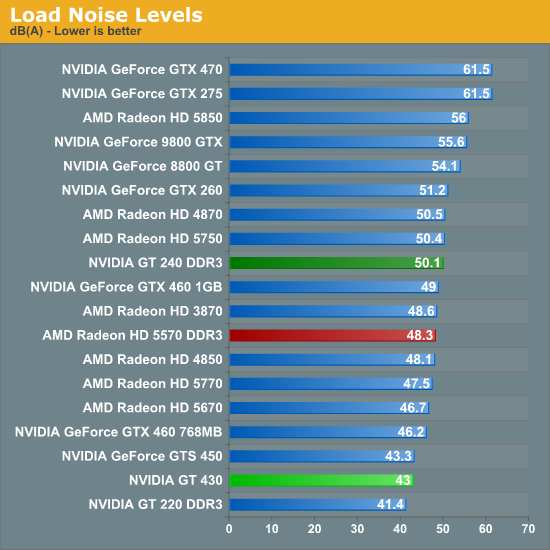
The payoff of accepting higher temperatures is less noise to contend with. The GT 430 never needs to ramp up its fan in our tests, delivering a load noise level even lower than the GTS 450, and only worse than a GT 220 that runs up against ambient noise levels. If you want to make a good HTPC card then it needs to be silent, and Asus/NVIDIA have delivered on that here. It’s not quite silent since it’s not passive, but it’s about as close as one can reasonably achieve. It’s also noticeably better than the 5570, a card which is by no means noisy. If noise is a primary concern then the GT 430 is a very good candidate for a HTPC.










120 Comments
View All Comments
Stuka87 - Monday, October 11, 2010 - link
The software they used in HQV 2.0 (Which they clearly state).And the software does not do all the processing. It only does the processing if there is no GPU to offload it too (ie: Very CPU intensive).
The GPU's drivers have a LOT to do with the image quality.
ganeshts - Monday, October 11, 2010 - link
Sorry guys, could have been more clear in the testbed setup. I will update the piece accordingly.Anyways, we use Cyberlink PowerDVD build 2113 with TrueTheater disabled and hardware acceleration enabled for playing back the HQV streams.
Please note that this is the HQV 2.0 benchmark suite, and has been tailored for HD unlike the DVD oriented HQV 1.0 suite.
hmcindie - Tuesday, October 12, 2010 - link
The POINT is to get the image to the screen 100% accurately. Not to enable noise removal (scoring noise removal, "edge enhancement" or anything other "improvements" are extremely dubious)Scoring video resolution after these "improvements" is silly. Some of those deinterlacing tests are also stupid because the only way to score a perfect 5/5 score is to make the drivers detect THAT EXACT scene. An algorithm which is more universal cannot get 5/5. That alone completely negates a lot of HQV tests.
The point of HQV is to make a suite of tests and ONLY products that have been HQV certified will pass them. A lot of those tests are synthetically fabricated especially now with Blurays.
ganeshts - Wednesday, October 13, 2010 - link
Interesting point, and I won't argue against your views (because they may be correct).However, stuff like cadence detection is independent of the stream. You are either capable of 2:2 pulldown or not. It has nothing to do with a particular stream. It is aspects like this which are problematic with the GT430.
MadMan007 - Monday, October 11, 2010 - link
It's a shame NV gave up trying even for mere performance parity. With even 8 ROPs (16 would have been great) and/or GDDR5 this might have been a suitable low-end/older game budget card and possibly a worthy successor to the late great 9600GT. Adding GDDR5 alone won't fix the lack of ROPs though and probably won't make a noticable difference unlike the GT 240 where the GDDR5 variants were notably better. Too bad because a lower-end/older game silent low power draw budget gaming card is exactly what I'd be interested in, and AMD drivers are too quirky for me.smookyolo - Monday, October 11, 2010 - link
I guess you skipped over the part where it said that this is NOT a gaming card?nitrousoxide - Monday, October 11, 2010 - link
We don't need low-end gaming card, neither do we need HTPC card anyway 'cuz Llano Fusion APU will wipe them out. The game is over for nVidia at low-end.ggathagan - Monday, October 11, 2010 - link
Yes, that *was* stated, and then followed by 9 pages of gaming benchmarks.If you're going to state that the card isn't meant for gaming, then don't run game tests and fill the article with gaming benchmarks.
There are 2 only pages discussing HTPC performance.
We all know it's targeted to HTPC, so expand your reporting on that aspect of the card's abilities.
MadMan007 - Monday, October 11, 2010 - link
I guess you skipped over the part where it said that the chip is a step back in terms of graphics-oriented functional units in favor of HTPC features?It's clear this isn't a gaming card, but the potential for making it a passable gaming card that is actually competitive with the going-on-10+-month old lower-end Radeons is what I'm lamenting. I generally prefer NV cards but doing worse than their previous product in this segment (saying it's meant to replace the horrid GT 220 is a joke) is just sad. It's all part of the 'more features, no better price/performance' trend in all but the high-end that's been going on for a year though so whatever..
nitrousoxide - Monday, October 11, 2010 - link
I don't know what's wrong with Mr.Huang, but doesn't he even feel ashamed to bring this c-r-a-p to the market?! The AMD Fusion APU will easily overrun it. There will be no future for nVidia if Huang keeps making such pathetic products. The release of HD6800 is in a few days, the first tests show that HD6850 can beat a GTX460 1GB and HD6870 easily overrun the GTX470 (and probably the incoming 384SP-GF104-GTX475). Once the good days for GTX460 are gone, nVidia will be in total disadvantage.